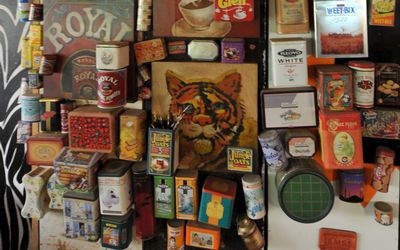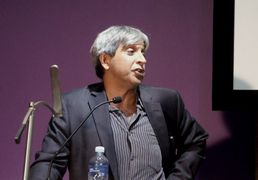SOME time ago, I went to see War of the Worlds at a cinema at the The Zone in Rosebank, Johannesburg. I wasn’t expecting to be hugely entertained by the not-so-well-written HG Wells story; I was more interested in how Steven Spielberg had updated the classic that sent people screaming into the streets when Orson Welles read it on radio in the 1930s.
Still, I wanted to follow the mumbled American dialogue and soon became extremely irritated by two moviegoers chatting away next to me. Since it is tricky for a middle-aged white male to upbraid sassily dressed young black women, I bit my tongue, but eventually I could stand it any longer.
"Can you please watch the movie?" I asked.
A rigid silence reigned for a good 10 minutes, then one of them burst out laughing. Glaring at the culprit, I saw this was not a new bout of giggling — she was holding her mouth as she stared with big eyes at the screen.
I said nothing, thinking there was little I could do about delinquent youngsters. But soon I discerned a pattern in the now raucous laughter from both. It came every time a serpent-like arm from an alien warship probed into the nooks and crannies of the heroes’ hiding place.
I realised they were watching the movie and finding it absurd.
...
AS PART of our western upbringing, the audience’s reactions had been subdued and we were sold on the story’s fancies. Not so the young black women next to me, who I now imagined could not relate to much in the movie, with its post-9/11 American paranoia and homely values.
Once I started watching it through their eyes, it became fascinating, I could see their laughter was an intelligent response to a cultural artefact that was aiming to replicate the exploitative propagandistic force of the Welles version of the 1930s.
Revulsion has been expressed after the recent burning of some paintings at the University of Cape Town. The backlash wiped out any gains these students thought they had made with their otherwise craftily planned Shackville protest.
I couldn’t help thinking about my fellow moviegoers as I felt the impulse to laugh out loud at the unblushing hypocrisy of the self-confirmed art philistines among us who dug up all manner of references — Wikipedia facts about the Nazis, Chairman Mao and Islamic State — as they turned a forgotten artist into the great master Richard Baholo, a victim of art vandalism.
Art in the thousands of shackvilles in SA is a vastly different practice to that of universities. What are called "found objects" — á la Marcel Duchamp and Pablo Picasso — are junk and rubbish in the townships, even though these serve to feed the creative impulses existing there as anywhere else.
Many shacks are decorated with adverts and packaging; sculptures are made from old gears, tins and pipes. In Zimbabwe, I once saw a torn piece of newspaper tacked onto a wall. For the shack dweller, it was simply a beautiful object, and the more it yellowed, the more it served as a cherished antique.
...
SO, WHILE the burning of paintings should be deplored, we should also examine carefully the intellectual alienation of which it speaks, and the enormous differences in economic context that remain at the heart of the disaffection driving the student uprisings.
We can start such an examination by recounting all the facts of the matter, not just some — such as that not all the paintings were burned, some were stolen. One steals a painting to put it to new use, even if you are just going to sell it.
Putting art to new uses that may be far less sublime or elevated than the original intention or wishes of the artist is part and parcel of the western tradition. They are, most often, consumerist traditions that during the 20th century helped to distort the impulse to create beautiful things with which all artists start out in their childhoods. But art also served propagandistic aims.
To what extent this happened is shown afresh in a new book, Cold War Modernists, which is what author Greg Barnhisel calls the US artists promoted in billion-dollar campaigns by a host of state agencies including the Central Intelligence Agency.
As the Los Angeles Review of Books notes: "The real story of American art and literature after World War II is buried in the file folders and meeting minutes of (bureaucratic) groups.
...
"BARNHISEL shows how these agencies (with unglamorous names like the Office of War Information and the Office of Facts and Figures) helped to transform a loose collection of anti-establishment, purposefully difficult artists into a prominent prong of Cold War diplomacy," the review states.
"The book captures the wide variety of institutions that, from the late 1940s until the mid-1960s, attempted to woo European and South American intellectuals away from their Soviet sympathies with an interpretation of modernism that emphasised freedom, individualism, and democratic debate."
Barnhisel shows how the term "modernism" came to be shaped by committees and bureaucrats as much as by academics and critics, as an antidote to the Soviet paradigm of "socialist realism".
Part of it, for example, was adopting Picasso as a modernist and promoting readings of his work that "emptied out" his well-established affiliations with various communist parties in Europe.
It does not change the worth of the art works. The fact that William Faulkner, a notorious drinker, worked so closely with the US government that the state department produced a pamphlet entitled, "Guidance Recommendations for Handling Mr William Faulkner During Official Tours," does not detract from his place in the canon of English literature as one of its greatest writers. Nor does it mean that Jackson Pollock should be grouped with the tabloid hacks, who like to say, "I can do that with a watering can too."
...
BUT, it does mean we should ask ourselves what George Orwell meant when he said, "All art is propaganda." And what that means in the South African context. If we accept that art is propaganda, or is amenable to it, can we excoriate people who laugh when they see through it or respond to it in other, negative ways?
Most art is an acquired taste. One has to immerse oneself in the peculiarities of an era and country’s traditions, history, and various other contexts before one can truly appreciate and enjoy — without much questioning — many works of art we accept as classics. Think of the not-really beautiful Mona Lisa, or a weighty Rubens nude, Tracey Emin’s unmade bed.
This is a doubly difficult task for black students who are still being forced to follow white, western curricula if they want to obtain an internationally acceptable degree.
It is not only black students who struggle. When I was a conscript in the army, some of my fellow officers puzzled over my choice of a poster of a Modigliani nude against my wall, and vocally expressed their distaste of "sick paintings". Most South African whites have a derisive approach to art that is not far removed from that of the Rhodes Must Fall arsonists. Most South African books fail to beat 600-copy sales, artists and dancers have to go abroad for a serious career, and musicians struggle to make a living.
So, while the Shackville students have done us all a favour by exposing themselves as black racists and have made manifest the black racism that has been there all along, dispelling the myth that racism is a whites-only thing, we should not avoid dealing with the challenge they pose to our cultural assumptions. One of which is that art is sacrosanct among all people.
We bluff ourselves when we think the misguided actions of some protests means we can continue with our easy submission to Eurocentric values and practices without any deleterious effects rebounding on us.

Shanty Town in Bloemfontein, where tourists can ‘experience’ shack life, exemplifies art in a different context. Picture: GALLO IMAGES/CHARL DEVENISH
SOME time ago, I went to see War of the Worlds at a cinema at the The Zone in Rosebank, Johannesburg. I wasn’t expecting to be hugely entertained by the not-so-well-written HG Wells story; I was more interested in how Steven Spielberg had updated the classic that sent people screaming into the streets when Orson Welles read it on radio in the 1930s.
Still, I wanted to follow the mumbled American dialogue and soon became extremely irritated by two moviegoers chatting away next to me. Since it is tricky for a middle-aged white male to upbraid sassily dressed young black women, I bit my tongue, but eventually I could stand it any longer.
"Can you please watch the movie?" I asked.
A rigid silence reigned for a good 10 minutes, then one of them burst out laughing. Glaring at the culprit, I saw this was not a new bout of giggling — she was holding her mouth as she stared with big eyes at the screen.
I said nothing, thinking there was little I could do about delinquent youngsters. But soon I discerned a pattern in the now raucous laughter from both. It came every time a serpent-like arm from an alien warship probed into the nooks and crannies of the heroes’ hiding place.
I realised they were watching the movie and finding it absurd.
...
AS PART of our western upbringing, the audience’s reactions had been subdued and we were sold on the story’s fancies. Not so the young black women next to me, who I now imagined could not relate to much in the movie, with its post-9/11 American paranoia and homely values.
Once I started watching it through their eyes, it became fascinating, I could see their laughter was an intelligent response to a cultural artefact that was aiming to replicate the exploitative propagandistic force of the Welles version of the 1930s.
Revulsion has been expressed after the recent burning of some paintings at the University of Cape Town. The backlash wiped out any gains these students thought they had made with their otherwise craftily planned Shackville protest.
I couldn’t help thinking about my fellow moviegoers as I felt the impulse to laugh out loud at the unblushing hypocrisy of the self-confirmed art philistines among us who dug up all manner of references — Wikipedia facts about the Nazis, Chairman Mao and Islamic State — as they turned a forgotten artist into the great master Richard Baholo, a victim of art vandalism.
Art in the thousands of shackvilles in SA is a vastly different practice to that of universities. What are called "found objects" — á la Marcel Duchamp and Pablo Picasso — are junk and rubbish in the townships, even though these serve to feed the creative impulses existing there as anywhere else.
Many shacks are decorated with adverts and packaging; sculptures are made from old gears, tins and pipes. In Zimbabwe, I once saw a torn piece of newspaper tacked onto a wall. For the shack dweller, it was simply a beautiful object, and the more it yellowed, the more it served as a cherished antique.
...
SO, WHILE the burning of paintings should be deplored, we should also examine carefully the intellectual alienation of which it speaks, and the enormous differences in economic context that remain at the heart of the disaffection driving the student uprisings.
We can start such an examination by recounting all the facts of the matter, not just some — such as that not all the paintings were burned, some were stolen. One steals a painting to put it to new use, even if you are just going to sell it.
Putting art to new uses that may be far less sublime or elevated than the original intention or wishes of the artist is part and parcel of the western tradition. They are, most often, consumerist traditions that during the 20th century helped to distort the impulse to create beautiful things with which all artists start out in their childhoods. But art also served propagandistic aims.
To what extent this happened is shown afresh in a new book, Cold War Modernists, which is what author Greg Barnhisel calls the US artists promoted in billion-dollar campaigns by a host of state agencies including the Central Intelligence Agency.
As the Los Angeles Review of Books notes: "The real story of American art and literature after World War II is buried in the file folders and meeting minutes of (bureaucratic) groups.
...
"BARNHISEL shows how these agencies (with unglamorous names like the Office of War Information and the Office of Facts and Figures) helped to transform a loose collection of anti-establishment, purposefully difficult artists into a prominent prong of Cold War diplomacy," the review states.
"The book captures the wide variety of institutions that, from the late 1940s until the mid-1960s, attempted to woo European and South American intellectuals away from their Soviet sympathies with an interpretation of modernism that emphasised freedom, individualism, and democratic debate."
Barnhisel shows how the term "modernism" came to be shaped by committees and bureaucrats as much as by academics and critics, as an antidote to the Soviet paradigm of "socialist realism".
Part of it, for example, was adopting Picasso as a modernist and promoting readings of his work that "emptied out" his well-established affiliations with various communist parties in Europe.
It does not change the worth of the art works. The fact that William Faulkner, a notorious drinker, worked so closely with the US government that the state department produced a pamphlet entitled, "Guidance Recommendations for Handling Mr William Faulkner During Official Tours," does not detract from his place in the canon of English literature as one of its greatest writers. Nor does it mean that Jackson Pollock should be grouped with the tabloid hacks, who like to say, "I can do that with a watering can too."
...
BUT, it does mean we should ask ourselves what George Orwell meant when he said, "All art is propaganda." And what that means in the South African context. If we accept that art is propaganda, or is amenable to it, can we excoriate people who laugh when they see through it or respond to it in other, negative ways?
Most art is an acquired taste. One has to immerse oneself in the peculiarities of an era and country’s traditions, history, and various other contexts before one can truly appreciate and enjoy — without much questioning — many works of art we accept as classics. Think of the not-really beautiful Mona Lisa, or a weighty Rubens nude, Tracey Emin’s unmade bed.
This is a doubly difficult task for black students who are still being forced to follow white, western curricula if they want to obtain an internationally acceptable degree.
It is not only black students who struggle. When I was a conscript in the army, some of my fellow officers puzzled over my choice of a poster of a Modigliani nude against my wall, and vocally expressed their distaste of "sick paintings". Most South African whites have a derisive approach to art that is not far removed from that of the Rhodes Must Fall arsonists. Most South African books fail to beat 600-copy sales, artists and dancers have to go abroad for a serious career, and musicians struggle to make a living.
So, while the Shackville students have done us all a favour by exposing themselves as black racists and have made manifest the black racism that has been there all along, dispelling the myth that racism is a whites-only thing, we should not avoid dealing with the challenge they pose to our cultural assumptions. One of which is that art is sacrosanct among all people.
We bluff ourselves when we think the misguided actions of some protests means we can continue with our easy submission to Eurocentric values and practices without any deleterious effects rebounding on us.























Change: -0.96%
Change: -0.78%
Change: -0.88%
Change: -0.57%
Change: -2.38%
Data supplied by Profile Data
Change: 0.47%
Change: -0.64%
Change: -0.96%
Change: 0.00%
Change: -1.12%
Data supplied by Profile Data
Change: -0.33%
Change: -0.32%
Change: -0.82%
Change: -0.15%
Change: 0.46%
Data supplied by Profile Data
Change: -0.67%
Change: -0.61%
Change: -0.26%
Change: -0.18%
Change: 2.05%
Data supplied by Profile Data